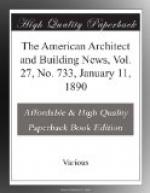In this rapid review of the civil architecture of the ancient peoples of Asia and Egypt, we have discovered no traces of structures whose destination indicated any care for the development of the lower classes of society, no remains which implied their participation in any municipal life whatever, no edifice erected for the purpose of national education. Such institutions had no place under a theocractic government which absorbed into itself the entire nation. When it had made provision for the defence of its cities, erected temples to its gods, reared palaces for the earthly abode of its monarchs and tombs for their future life, when it had satisfied the simple material needs of the people, what more could be asked?
[To be continued.]
FOOTNOTES:
[Footnote 1: From the French of G. Guicestre, in “Encyclopedie de l’Architecture et de la Construction.”]
[Footnote 2: Perrot and Chipiez. “Histoire de l’art dans l’antiquite.”]
* * * * *
[Illustration: Paris]
The pavilions of the city
of Paris.—Domestic and
urban
sanitation.—Views of old
Paris.—Palaces of the
liberal arts and the
fine arts.—Retrospective
exhibition of labor.
The City of Paris desired to have in the Champ de Mars a serious and useful exhibition, so it began by paying no sort of attention to the decorative and architectural side of its two pavilions, placed in the centre of the upper garden between the monumental fountain and the central dome. It was not afraid, in spite of its surroundings, to shelter itself within the simplest of buildings in plaster, with a decoration meagre and accentuated by the needs of construction. In fact, the large entrance doors, all of wood, were made afterwards and applied to the plaster, and the same may be said of all the visible woodwork; but this lack of ingenuousness in the construction is not to be too severely blamed, since it is a question of pavilions which are to disappear after an existence of six months. Economical reasons are always worthy of respect, and the modesty of the Municipal Council on this occasion ought to be praised. But what one has a right to criticise is the unhappy idea which placed these pavilions in such a manner as to completely obstruct the view of the exterior porticos of the palaces and industrial sections when one stands before the central dome in the centre of the garden. This criticism once made, there only remains to give expression to praise of the exhibit made by the city of Paris. Very well arranged inside, very well considered, it possesses enormous interest principally from the point-of-view of hygiene and the sanitation of the city. This is a question




